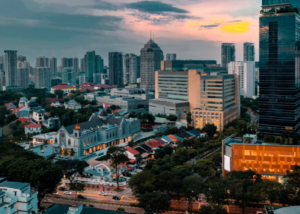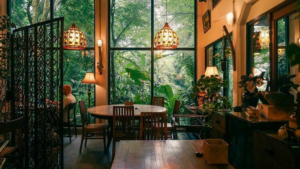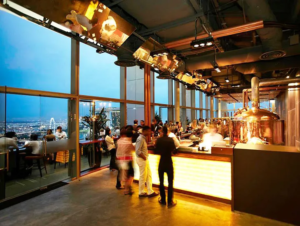
Despite Singapore being a dazzling city inundated with beautiful skyscrapers, several forgotten zones have decaying mansions, abandoned towns, and wartime relics. In times past, these places were full of life, but today, they are a shadow of their former glory.
Nevertheless, they still attract tonnes of visitors who want to learn about the history of Singapore. Since most of these places are deserted, it would help to explore them with your friends rather than visit them alone. Keep in mind some of these places are prohibited from the public; therefore, you can observe them from a distance. Please scroll through the article to discover some of the abandoned places in Singapore and their stories.
1. Dakota Crescent

Dakota Crescent is among the oldest housing estates in Singapore, built-in 1958. In 2016, its residents were relocated by the government to pave the way for the redevelopment of low-rise brick-clad flats. Dakota Crescent was the first estate in Singapore that provided a decent standard of living for its residents since it had one-roomed apartments. Water and electricity were available on every floor, including garbage chutes that helped improve sanitation.
Most residents in Dakota Crescent forged strong friendships with each other, allowing them to live as a united community. Since many of the residents that occupied the estate were the elderly, they would frequently meet for coffee and interact with their neighbours, thus creating a sense of belonging for them to the place. The famous dove playground kept children in the estate entertained while allowing their parents to monitor them from their flats to ensure they were safe.
In addition, the residents living in the estate came from different races and dialects, which enriched the language diversity of the area. Although the estate was a buzzing city with life in times past, it is currently a ghost town as its residents were relocated to other estates by authorities. Most Singaporeans love to visit Dakota Crescent to learn about the history of Singapore. Moreover, the once vibrant dove playground is toured by school children as part of heritage trips.
2. Istana Woodneuk

Istana Woodneuk is an expensive abandoned mansion that belonged to the Sultan of Johor. The mansion is located in a hidden mass of vegetation between Holland Road and Tyresall Avenue was built for the fourth wife of the Sultan in the 19th century. When the wife died, Sultan sold out the house to Sultan Ibrahim, and later it was used as the General’s headquarters and a military hospital.
The former palace has endured the test of time from human brutality and nature. In 1942, Istana Woodneuk was bombed by the Japanese and killed approximately 700 medics and patients. Additionally, in 2006 its glorious blue roof and much of the upper structure were significantly destroyed by fire. Despite its rough past, it’s a wonder that the first floor remains intact and can still feel its magnificence from the flooring timber cladding on the walls. Its living hall, a spacious room with a ceiling decorated with cornices, is still intact.
The timber screen doors along the house have long decayed, and most of the area is covered with a vast expanse of greenery. The balconies and steel railing on the main staircases are decorated with floral designs, topped with elaborate timber handrails. The abandoned palace has been a famous go-to place for local explorers, drug addicts, and worshippers. The entire area is filled with graffiti images that are artistically impressively, while some are scary enough and resemble a ceremonial haven for pagan worship.
The mansion is now home to hornets and thousands of mosquitoes making the whole place appear more dangerous. Although some people are brave enough to visit the mansion alone, the experience is nerve-wracking and will send chills down your spine as you stroll through the tired and worn-out walls and staircase filled with debris. Recently the authorities in Singapore have restricted visiting the place since its dangerous; therefore, you can appreciate Istana Woodneuk through images and stories to learn about its richness and heritage.
3. Chee Guan Chiang House

Chee Guan Chiang House is a massive ramshackle bungalow located along Grange Road and Devonshire Road in Singapore. The beautiful mansion covers a land area of 100 000 square feet and showcases various art deco features with a rounded façade. Moreover, the house is among some of the most expensive bungalows in Singapore, with its current value reaching half a billion dollars, including the entire plot of land with the house on it.
The house is surrounded by overgrown flora and has a shoddy driveway that leads to the home. The private bungalow is restricted from public access with sufficient warnings with trespasses getting into the wrong side with the law. Owning a building is a challenge for many Singaporeans baffled by why someone would abandon such a large iconic mansion. Although the mansion’s areas are highly developed, the prime property remains a wasteland and deserted.
After its construction in 1938, the Chee family did not occupy it for long due to World War II, which hit Singapore, leading to their fleeing the country because of the Japanese occupation in 1941. Subsequently, the house became a traveller’s guest house after the war ended. A land tussle ensued over Chee Guan Chiang House when subdivided into four houses and a road.
One new owner, Lee Tat Properties, bought three houses while the authorities sold the remaining house to Grange Heights, who intended to convert the land into a tennis court and a garden. The two property owners could not agree on using the road, forcing Lee Tat to build an iron fence to prevent Grange Heights residents from using the road. The Chee Guan Chiang house was locked in legal limbo for more than 30 years, leading to its abandonment and dilapidated state.
4. Marsiling WWII Tunnel and Naval Base

Marsiling WWII Tunnel and Naval Base is an underground military tunnel located in the Marsiling jungle built by the British as storage for oil supply for British Royal Air Force. Additionally, the tunnel is located on a small hill between Admiralty Road West and Marsiling Crescent and was abandoned after Singapore gained independence in 1965.
The tunnel, discovered in the early 2000s, has two storeys descending below the ground and is an ideal hotspot for historians and explorers. In 2014 during Singapore’s 72nd anniversary of independence, the authorities opened the tunnels for the public to visit and explore. The National Heritage Board provided Singaporeans with a guided tour to the tunnel to enlighten people about how the British surrendered their country to the Japanese.
Although the tunnel has been sealed and closed to the public in recent times, some local explorers have dug a small opening at the entrance to allow them to access the abandoned tunnels that speak about Singapore’s heritage. The underground tunnel is now home to spiders, creepy crawlies, giant geckos, and centipedes that are guaranteed to send chills all over your body.
5. Matilda House

Matilda House was the most iconic property in Punggol, housing six bedrooms, a raised floor, and an entrance on both ends. The property had a horse stable, a tennis court, a massive orchard that grew tropical fruits, including durians and mangosteens, and servant’s quarters within the compound. The orchard’s calming breeze protected the property from the heated weather of Singapore.
Matilda House has stood the test of time by surviving two world wars, making it the oldest bungalow in Singapore. The house belonged to the Cashin family, the wealthiest Eurasian family in Singapore in the 19th century. The owner Joseph William gave the 417 square meters Matilda House as a gift to his wife, Josephine Matilda Cashin, hence the house’s name.
In the 1980s, the Singapore government underwent reforms in land acquisition, reclaiming over a million square meters of land in Punggol, forcing the eviction of the Cashin from the Matilda house. Financial woes and lack of demand led to the house’s failure to develop, thus leading to its abandoned state.
Due to its deteriorating state, villages passing through the house claimed to see a lady with long hair sitting on top of a tree to guard the mansion from intruders. Others reported seeing a white mist floating along the house’s corridors, claiming it was being haunted. According to locals, some three construction workers mysteriously disappeared in an attempt to demolish Matilda House, forcing the developer to desert the project and keep it off from the site.
Fortunately, in 2010 a new developer, Sim Lian Group, bought Matilda House and converted it to a clubhouse without demolishing it. During the renovation, the developer involved spiritual masters in helping him negotiate with spirits lingering in the house. The fear of the ghosts still lives on today, with the lights at the clubhouse never switched off to ensure maximum safety. Although given a new lease in life, Matilda House lives on to tell the tale of its haunted history.
6. Neo Tiew Estate

Neo Tiew Estate was once a bustling estate located in Lim Chu Kang; the town is currently abandoned and used for military training; thus, it is out of bounds. Although the Neo Tiew Estate was small, it consisted of two four-story residential slab blocks with shops, a wet market, and a playground for the children within the estate.
The ghost town was named after a businessman who pioneered the development of Lim Chu Kang in the early 20th century. Due to its increased dilapidated state, locals began tales claiming to haunt Neo Tiew Estate. A famous story is about a gambler who stuck seven needles into a banana tree to compel the spirits within the building to provide him with winning lottery numbers. Upon hitting the jackpot, the gambler neglected to remove the needles, killing the tree and angering the spirits.
Even though the abandoned Neo Tiew Estate is out of bound to the public at present, you can get a glimpse of its past by observing from afar when passing by bus through Lim Chu Kang. Therefore, for your safety, it would help to keep off the Neo Tiew Estate or risk bumping into hundreds of army troops during their training; thus, risk your being on the wrong side of the law for trespassing.
7. Old Changi Hospital

Old Changi Hospital is the present-day defunct general hospital in Changi, which began operations in 1935. The hospital was later taken over by the Japanese military police, who used the building to lock more than 50,000 prisoners of war and as a torture chamber during their occupation in Singapore. Today, when you visit the hospital, you will see the thick chains hanging from the walls and blood-stained floors depicting the brutal torture techniques used by the Japanese.
At the end of World War II, the British used it as their military hospital, including the Singapore Armed Forces. Through the years, reforms made on the hospital saw the hospital open to the public, serving the military staff and their families. Vandalism and slander about Satanists using the rooms as a site for demonic practices led to the closure of services at the hospital.
The hallways, awash with staff and patients, turned into spaces for trespassers and vandals. Today the deserted building still stands vacant to tell about Singapore’s heritage. The building is prohibited from entering with security officers guarding the premises. You can observe the Old Changi Hospital from afar or enjoy a virtual tour of it from the comfort of your condo.
8. Fort Serapong

Fort Serapong is a sprawling military abandoned complex with tunnels, bunkers, and underground spaces. The complex is located at the North-Eastern edge of Sentosa Island and was built between 1870 and 1890. Fort Serapong is surrounded by an overgrown jungle with no manicured or regulated adventure space. Additionally, the buildings on the complex are extremely worn-out from the intense jungle foliage and tropical climate over the years.
The purpose of building the port was to keep pirates at bay during World War II. Adventures seekers can have a sigh of relief to learn that Fort Serapong is accessible via guided tours. The tour will include artificial trails, rough cement grounds covered with debris, and small makeshift bridges inside the fort. Ensure to bring enough water and snack and wear comfortable shoes to experience an adventure of a lifetime at Fort Serapong.
9. Tanglin Hill Brunei Hostel

The Brunei government constructed the hostel during the mid-1950s to facilitate accommodation for students studying in Singapore. Since the Brunei government had not established a proper education system, they sent their best-performing students to Singapore and provided lodging at Tanglin Hill Brunei Hostel. Initially, the building adopted a colonial-style architecture, but with increased demand of the students, the Brunei government built a more modern multi-storey dormitory.
In 1983, the Brunei government established its education system and decided to shut down the hostel, abandoned since. Although the hostel was a bustling dormitory thronged by students, today, the building looks dilapidated with graffiti artworks on its walls and rumoured ghost sightings. Its ceiling has since collapsed and rubble littered everywhere as the building succumbed to the embrace of nature.
10. Bukit Timah Railway Station

The railway station was opened in 1903 and was initially owned by the Malaysian government. In July 2011 Singapore government took over Bukit Timah Railway Station and opened it to the public. Today the railway station remains in the state it was vacated, and it has not been developed nor reconstructed.
Although the railway station is no longer used, it stands as a sentimental reminder of Singapore’s railway heritage. Most of the tracks on the railway were removed, with only a few left for explorers who frequent the station. Most Singaporeans visit the rustic space to experience a relaxing haven from the busy city life and take panoramic shots along the beautiful scenic views of the station.
Do you feel like visiting these abandoned places to see first-hand what goes on there? Book your Shariot and head for an adventure of a lifetime. Our cars can take you anywhere you want to go in Singapore at an affordable hourly price.






No comment yet, add your voice below!